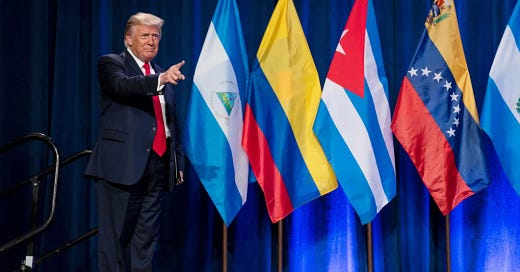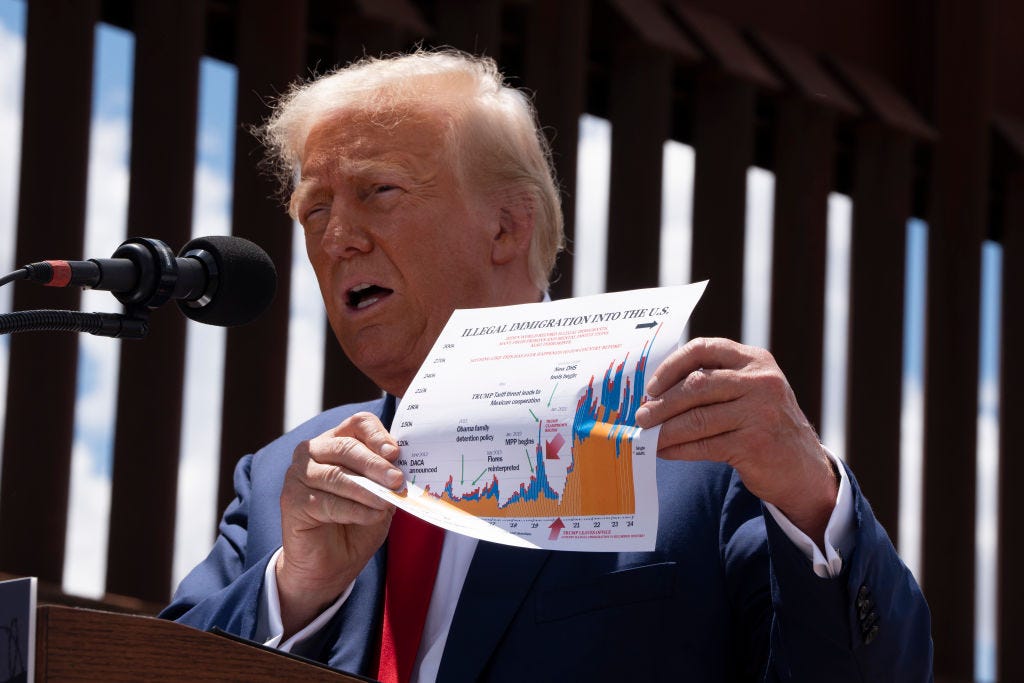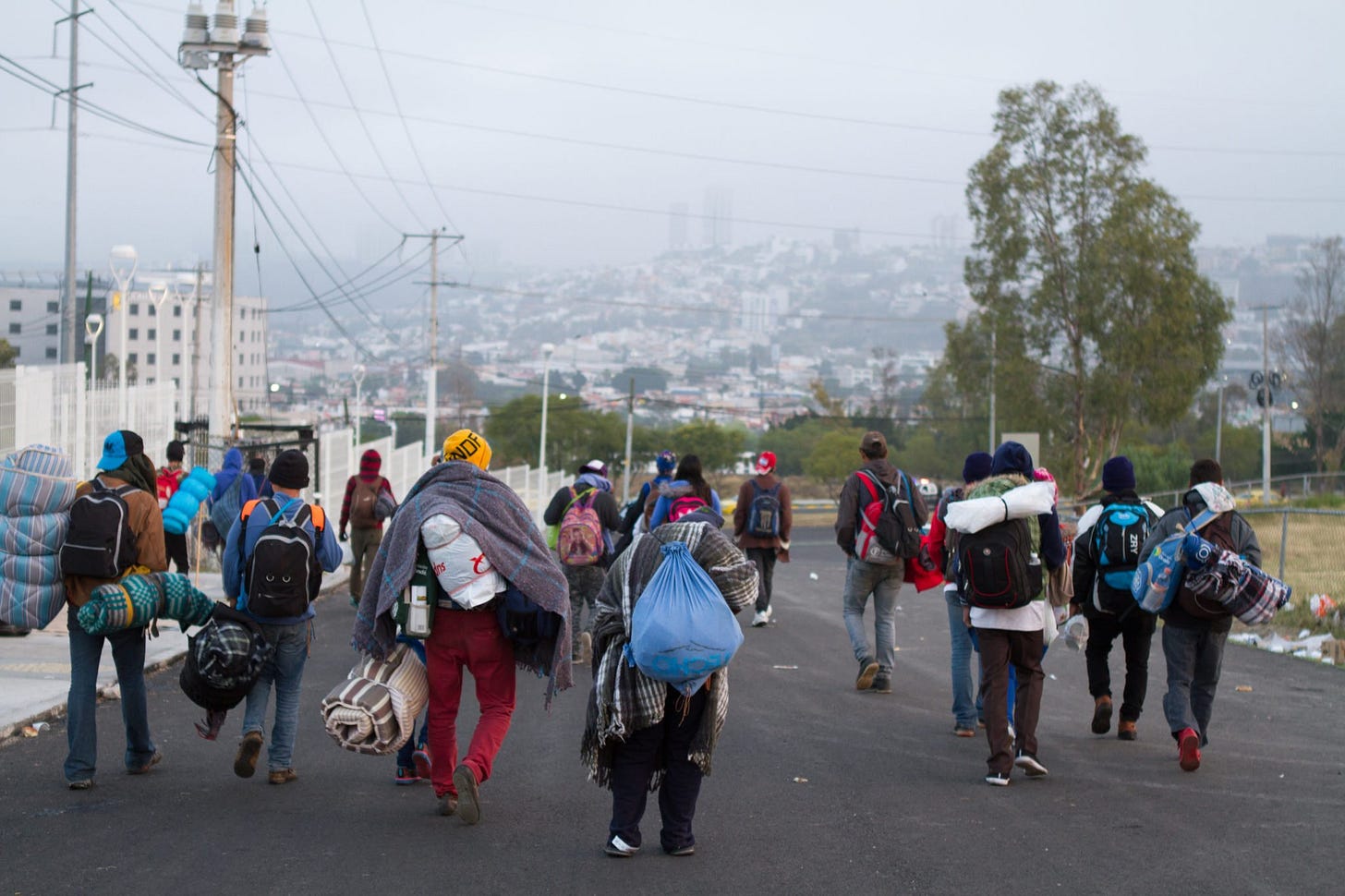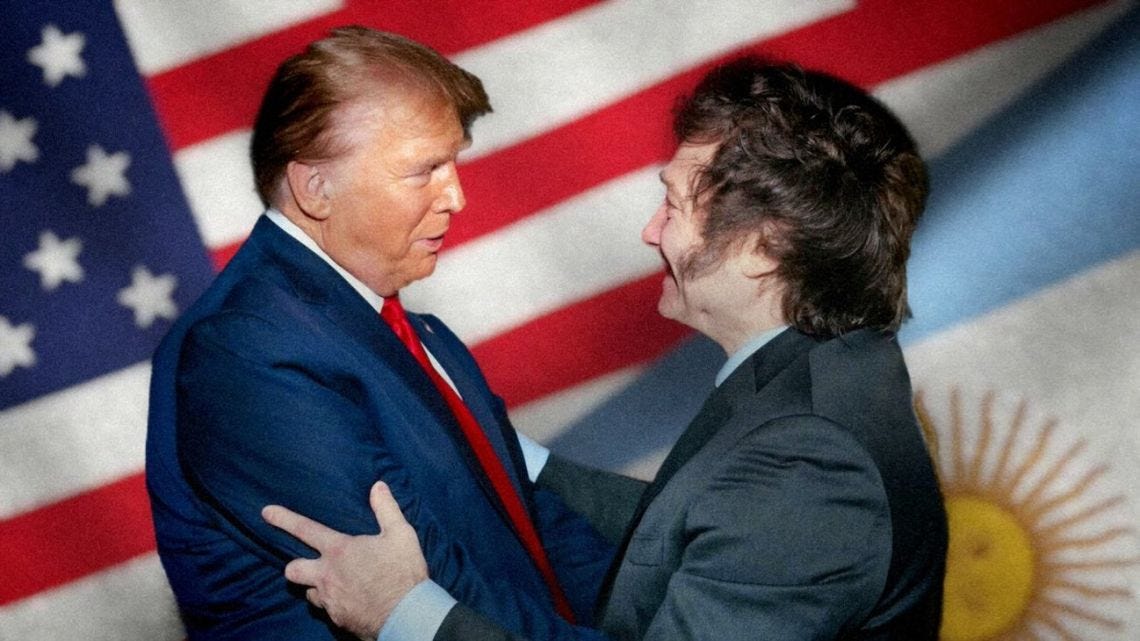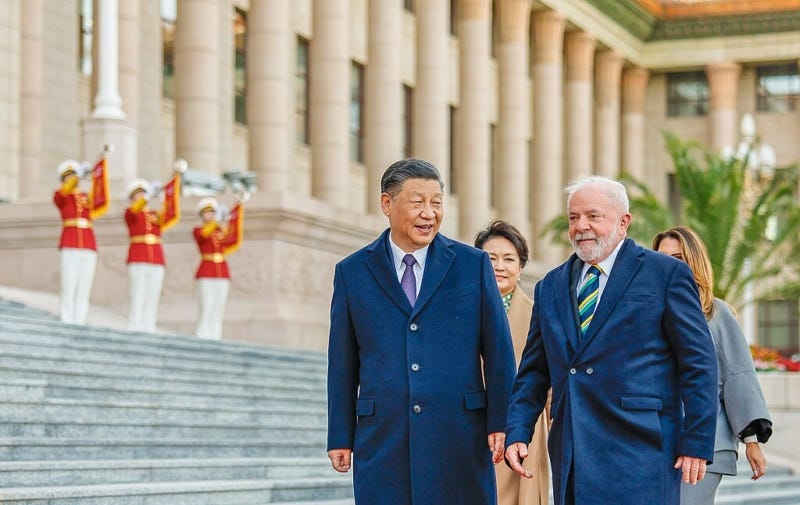Strengthening Ties or Stirring Tensions? An Analysis Of Trump’s Potential Influence on Latin America’s Geopolitical Landscape
Analyzing the Effects of Trump’s America First Policies on Latin American Trade, Security, Migration, and Relations With U.S. Adversaries
Executive Summary
This report assesses the potential impact of Donald Trump’s second presidential term on Latin America, focusing on trade policies, migration, security, and the influence of external actors in the region. The report makes analytic judgments and assumptions based on Trump’s "America First" policy framework and observable shifts in his administration’s stance on Latin American issues.
Key Judgments:
Trump's administration will likely implement protectionist economic policies, which may strain trade relations with Latin American countries. The emphasis on renegotiating trade deals in favor of U.S. interests (i.e., potentially revising USMCA terms) is expected to disproportionately affect Mexico and Central America, where economies are highly dependent on trade with the U.S.
Immigration restrictions and enforcement measures are expected to intensify under Trump, which will likely affect Central American nations reliant on remittances. Tighter immigration policies could disrupt economic stability and increase political tension within these countries, as local economies rely heavily on funds sent back by their nationals working in the U.S.
Trump will likely adopt a more aggressive approach to security funding and counter-narcotics initiatives in Latin America, driven by his administration’s historically strong stance on reducing drug trafficking and combating organized crime. This assessment is based on Trump's prior emphasis on kinetic operations and security partnerships with allies in the region, which suggests a continuation, if not expansion, of these strategies.
Latin American countries with left-leaning governments will likely experience more strained diplomatic relations with the U.S., as Trump's administration may pursue sanctions or other punitive measures against states that adopt policies contrary to U.S. interests. Venezuela, Cuba, Nicaragua, and Bolivia are assessed as particularly vulnerable due to existing U.S. sanctions and their current alliances with U.S. adversaries.
In response to a perceived shift in U.S. foreign policy, Latin American countries are expected to seek stronger ties with alternative powers, especially China. Given China's active role in the region, we assume Latin American states will increasingly engage with Chinese investment, trade, and infrastructure projects to offset U.S. economic pressures, potentially weakening the U.S.’s historical influence in the hemisphere.
Broader Implications
Should Trump’s administration proceed with a more isolated and transactional approach to Latin America, this could lead to increased economic and political fragmentation within the region. Countries aligning with U.S. interests may gain short-term benefits, but the broader region could experience heightened internal divisions and dependence on non-U.S. actors, particularly China. Such a shift may result in diminished U.S. influence and impact long-term security, economic, and political stability across the hemisphere.
(Photo Credit: Rebecca Noble | Getty Images)
Introduction:
As President-Elect, Donald Trump prepares to take office for his second term in January 2025, some Latin Americans joyfully wait in anticipation while others brace for another round of “America First” foreign policy that could trigger serious economic and social ripple effects across the region. When Donald Trump first assumed the presidency in 2017, his policies in Latin America introduced a complex shift in the dynamics of U.S.-Latin American relations. While his administration’s approach to the region has often been portrayed through the lens of immigration and strict border controls, his policies extended far beyond this singular issue. In reality, the Trump administration’s actions in Latin America spanned economic policies, trade restrictions, and a broader emphasis on "America First" that realigned U.S. interactions in the hemisphere. The Trump administration became more selective and often transactional in its regional engagements, weakening U.S. influence and leaving a vacuum that other global players were quick to exploit.
The political landscape in Latin America has changed considerably since 2017, presenting new challenges for Donald Trump’s second term in office. While on the surface it may appear that Trump’s foreign policy stance on Latin America has not changed much since his first term with a heavy emphasis on mass deportations and strict immigration controls, his economic protectionism has the potential to seriously impact many Latin American economies, which rely heavily on trade with the United States. Additionally, Trump’s stance toward ideologically aligned leaders, strained relations with Mexico, tensions with left-leaning governments, and a hardline approach to adversaries like Venezuela, Cuba, and Nicaragua will all play roles in reshaping U.S.-Latin American relations. The influence of organized crime and the increasing involvement of global powers like China, Russia, and Iran in the region further add to the importance of effective U.S. strategic engagement. Together, these elements form the backdrop for understanding how a second Trump term may reshape U.S. influence across the region.
Mass Deportations & Stricter Immigration Policies:
Mass deportations of Central American migrants under a second Trump administration could have severe economic, social, and political repercussions across the region. Central American countries, especially El Salvador, Honduras, and Guatemala, rely heavily on remittances from migrants in the United States, which comprise 24.3% of GDP in El Salvador, 26.9% in Honduras, and 19.4% in Guatemala1. A sudden reduction in these financial inflows would strain local economies, which are already struggling with high poverty levels, unemployment, and limited social services. When deported migrants return, many will face difficulties finding employment in these weak economies, especially as many lack resources, property, or family ties after spending years living in the U.S. With few legal opportunities, some individuals could turn to informal or illicit work to survive, potentially leading to an increase in organized crime recruitment, which is already a major destabilizing factor across the region.
The pressure of mass deportations would also likely drive up regional migration, with many deportees seeking to re-enter the United States or migrate to other countries. This could overwhelm both Mexican and U.S. border systems, as well as strain regional agreements on migration management. Politically, these dynamics could sour Central American-U.S. relations, as governments in the region might view the U.S. actions as undermining their economic stability. Socioeconomically, increased unemployment, declining public services, and weakened local economies would likely exacerbate poverty and inequality, potentially fueling public discontent and contributing to a more volatile political climate. Mass deportations could destabilize Central American societies already grappling with significant economic hardship, crime, and governance challenges, leading to a cycle of instability and heightened migration pressure across the region.
Trump is likely to leverage his relationship with leaders who are ideologically aligned with him, such as El Salvador's President Nayib Bukele. In this case, Trump might negotiate terms that allow for a reduced number of deportations or phased deportations of Salvadorans in exchange for support on key issues such as security cooperation or immigration enforcement at Salvadoran borders. Bukele, who has actively worked to improve El Salvador's safety and global reputation2, might see value in a deal that reduces the flow of returning migrants who may lack job opportunities and could place strain on El Salvador's social systems. As a result, Trump could ease the immediate return of certain categories of Salvadorans or focus deportation efforts on individuals with criminal backgrounds, which would be easier for Bukele to absorb domestically.
(Photo Credit: Alexei Wood)
Honduras has high migration rates to the U.S., driven by violence, poverty, and political instability with almost 500,000 estimated migrants living in the U.S.3 President Castro, who leans left politically, has criticized past U.S. policies, but she may consider collaboration on migration if it included financial or developmental aid. The Biden administration had allocated $4 billion in development aid to Central America4, targeting poverty and violence, which are primary drivers of migration. Trump’s prior emphasis on cutting aid could prove a sticking point; however, he might negotiate a more focused aid package tied directly to migration reduction. If Castro agrees to work with U.S. immigration priorities, Trump could target support for anti-gang initiatives or local infrastructure projects, showing concrete benefits for Honduran communities to counter migration incentives.
In Guatemala, President Arévalo, a left-leaning reformist, recently took office on an anti-corruption platform and is navigating a tense political landscape with conservative opposition5. Guatemala plays a critical role in migration patterns due to its geographic position as a transit country. Trump might see an opportunity to collaborate with Arévalo on security and border control, given the significant number of Guatemalans seeking to reach the U.S. Historically, Guatemala has cooperated with the U.S. on migration issues; under Trump’s first term, Guatemala agreed to a “safe third country” deal, requiring asylum seekers to apply for protection there rather than continuing to the U.S.6 With Arévalo, Trump might push for a similar arrangement, possibly providing security assistance in exchange, as Arévalo seeks to reform Guatemala’s institutions and boost security. However, Arévalo’s progressive stance may limit his willingness to adopt hardline migration policies.
Trump’s transactional style could even extend to adversarial relationships, like that with Venezuelan President Nicolás Maduro. In exchange for repatriating Venezuelan migrants, Trump might consider easing certain economic sanctions or offering limited humanitarian aid for Maduro’s acceptance of deported Venezuelans. This strategy would not likely signal a shift in Trump’s stance on Maduro’s regime but rather serve as a pragmatic deal. For example, Trump might offer minor relief on targeted sanctions that impact oil or other sectors critical to the Venezuelan economy if Maduro agrees to accept a significant number of repatriated Venezuelans. However, given Maduro’s continued hold on power and strained U.S.-Venezuela relations, Trump would likely proceed with caution and offer only enough relief to secure deportations without empowering Maduro’s regime.
(Photo Credit: Infobae)
Trump’s relationship with Colombian President Gustavo Petro would likely be tense due to significant ideological differences and conflicting priorities, especially regarding migration and security. Petro, Colombia's first leftist president, has openly criticized the U.S.'s historically hardline approach to Latin American migration and drug policy7. Trump’s emphasis on border security and restricting immigration contrasts sharply with Petro’s support for humane migration policies. Colombia, under Petro, has accepted nearly three million Venezuelan migrants as part of an open-border approach to the humanitarian crisis, which Petro frames as an issue of human rights. Trump, however, will view Colombia as a strategic partner in discouraging northward migration, especially as the Darien Gap, a critical passage for migrants moving through Colombia to Central America and eventually the U.S., has seen an increase in crossings in recent years8. Trump may pressure Petro to impose stricter controls in the region, however, Petro would likely resist such demands, given his stance on migrant rights and his criticism of U.S. interventionism. Trump might escalate public criticism of Petro and alongside other ideologically aligned Latin American political figures, could use rhetoric to isolate him, framing his migration policy as detrimental to regional security. Trump has often used public condemnation as a tactic to pressure foreign leaders who oppose his policies9. Such criticism could make it difficult for Petro to justify his policies at home, especially if the Colombian public perceives that a breakdown in U.S.-Colombian relations is negatively impacting their economy and security.
Trump's approach to immigration with Mexico under President Claudia Sheinbaum is likely to be contentious, given their ideological differences and Sheinbaum’s progressive policies. Trump has consistently pushed for Mexico to serve as a migration buffer, a role that was cemented during his first term through the Migrant Protection Protocols (MPP), often known as "Remain in Mexico”10. This policy required asylum seekers, many from Central America, to await their U.S. court dates in Mexico rather than in the U.S., creating strain in Mexican border regions. Sheinbaum, a leftist with a strong focus on human rights, is likely to resist reinstating such policies fully. However, Trump may apply diplomatic pressure by threatening tariffs, as he did in 2019 when he threatened to escalate tariffs unless Mexico curbed migration11. This approach successfully led López Obrador’s administration to deploy 25,000 National Guard troops to the southern border.
Furthermore, Trump could target remittances, which are a crucial source of income for many Mexican families. In 2022, remittances to Mexico surpassed $61 billion12. Sheinbaum would likely view any policy impacting remittances as detrimental to her support base, especially as she enters her first term. Additionally, Trump might increase U.S. border security efforts, potentially recruiting thousands of border agents or seeking military involvement in counter-cartel operations, a proposal many Republicans support13. These actions could prompt Sheinbaum to push back strongly, emphasizing Mexican sovereignty and demanding respect for her country’s handling of internal security. Although both nations have a shared economic dependency, Trump’s tactics could create significant tensions, pushing Sheinbaum to seek a middle ground where she could retain some autonomy on migration policy while still avoiding Trump’s punitive measures.
Protectionist Economic Policies:
Beyond migration issues, U.S.-Mexico relations would likely deteriorate under Trump due to his protectionist economic stance, especially regarding Mexico's role in bypassing U.S. tariffs on Chinese goods14. Since 2018, Chinese manufacturers have increasingly assembled products in Mexico to avoid direct U.S. tariffs, creating friction between Trump’s administration and Mexico’s trade practices. If elected, Trump may consider reintroducing tariffs on Mexican imports or renegotiating parts of the United States-Mexico-Canada Agreement (USMCA) to close loopholes that allow China to benefit indirectly. Mexico’s economy, with over 80% of its exports destined for the U.S., would be significantly impacted by such moves. In 2022, the U.S. imported nearly $455 billion in goods from Mexico15, reflecting the depth of their trade relationship. A tariff increase or new restrictions could pressure Mexican industries that rely heavily on U.S. demand, including the automotive and electronics sectors. While Trump’s actions could strain diplomatic relations, the deep interdependence between the two economies might constrain extreme protectionist measures, as both countries would suffer economic setbacks. Nonetheless, Trump’s intent to curb indirect Chinese trade may lead to intense bilateral negotiations, with Mexico possibly seeking concessions or protection for key industries under the USMCA framework.
(Photo Credit: Saul Loeb | AFP | Getty Images)
Trump's protectionist economic policies would also significantly impact Latin America as a whole, especially as the region relies on trade with the U.S. in sectors like agriculture, manufacturing, and energy. For Trump-aligned governments like those in Argentina, Paraguay, El Salvador, Ecuador, Uruguay, and Perú, there may be hopes of receiving favorable terms through alignment on migration, security, or political stances. However, Trump's “America First” approach means these governments may still face stringent trade measures. The Trump administration's primary focus on shielding American industries could override ideological alliances when it comes to trade policy.
In Argentina, Trump may prioritize trade relations with President Javier Milei, a strong ally, but Argentina’s economic reliance on U.S. exports, particularly in agriculture, could limit these ties. Despite Milei’s alignment with Trump on issues like deregulation, Argentina’s agricultural exports could still face tariffs if they compete with American industries. However, Argentina’s vast shale reserves in Vaca Muerta could present a mutually beneficial opportunity16. Given Trump’s emphasis on energy independence and support for American energy companies, closer ties might encourage U.S. investment in Argentina’s oil and gas sector. Such investment could help Argentina increase energy exports and stabilize its energy economy. In addition, Argentina could receive U.S. support for infrastructure projects related to resource extraction and energy transportation, which would strengthen Argentina’s energy sector, boost its economy, create jobs, and improve infrastructure.
For countries like Chile, Colombia, and Brazil, which are less ideologically aligned with Trump, the economic impact could be even harsher. Chile's copper exports, which play a major role in its economy, would likely face new tariffs under Trump’s protectionism if they threatened U.S. industries. Chile might also struggle with Trump’s potential policies toward China, a key trading partner for Chile, as any trade wars between the U.S. and China could disrupt markets for Chile’s primary exports. In Colombia, President Gustavo Petro’s left-leaning policies and open opposition to Trump’s stance on migration and other issues could intensify friction. Colombia’s exports, such as coffee, oil, and gold, would be at risk if Trump decides to penalize countries with opposing political views or renegotiate the terms of trade deals to favor U.S. industries. Colombian leaders may also find it challenging to negotiate favorable terms given Petro’s ideological opposition to Trump, potentially affecting Colombia’s already fragile economy. Brazil, as Latin America’s largest economy and a key exporter of agricultural and industrial goods, would be closely watched by the Trump administration. Although the U.S. remains a critical market for Brazilian exports like steel and soy, a protectionist stance could push Brazil to seek closer trade ties with China and the EU. Bolsonaro, Brazil’s former right-wing president, initially had warmer relations with Trump, but current President Lula da Silva’s contrasting stance on social and environmental issues may push Trump to impose tariffs on Brazilian exports or demand that Brazil align more closely with U.S. strategic objectives such as counter Chinese economic influence in the region or completely isolating Maduro’s Venezuela.
Regional Relations:
If countries like Colombia, Brazil, or Chile, do not comply with Trump’s strategic goals and policies, such as counter-narcotics, migration, or decoupling from China there could be several potential consequences that go beyond tariffs. A reduction in U.S. support for security cooperation, especially in drug enforcement, could lead to a resurgence in violence, particularly from drug cartels and guerrilla groups in Colombia17, destabilizing regions already vulnerable to these threats. In Brazil, a refusal to align with Trump could spark increased political instability, as seen after Bolsonaro’s defeat, with mass protests and deepened polarization18. Similar instability could arise in Colombia or Chile, where ideological opposition to Trump might fuel domestic strife, with U.S. pressure exacerbating political tensions. Furthermore, Trump’s preference for right-wing leaders in Latin America could intensify regional divides, leading to greater fragmentation within organizations like the Organization Of American States (OAS). Countries that fail to meet Trump’s demands could find themselves excluded from key diplomatic discussions and trade negotiations, weakening their ability to secure favorable agreements. Without U.S. military and economic support, which countries like Colombia rely on for drug enforcement, security cooperation, and economic growth, these governments may struggle to maintain order and protect citizens, potentially leading to higher levels of crime, corruption, and instability.
(Photo Credit: JMilei | X)
Trump’s strategy toward regional adversaries such as Cuba, Nicaragua, Venezuela, and Bolivia would likely focus on economic sanctions, diplomatic pressure, and covert actions to isolate these regimes while asserting U.S. influence in the region. Historically, Trump used sanctions as a key tool, particularly against Venezuela and Nicaragua. His administration targeted Venezuela's oil sector, crippling its economy, and this strategy would likely expand under a second Trump presidency to include industries like gold and oil. Sanctions on key officials within the Maduro regime would likely increase, further isolating Venezuela from global markets. Similarly, sanctions targeting Nicaragua, especially President Ortega’s family and officials, would remain in place and potentially expand if the regime's authoritarian crackdown intensifies. Trump's approach to Cuba, which includes reinstating restrictions on trade, travel, and remittances, would likely continue. These measures aim to weaken the Cuban economy and challenge Díaz’s regime’s stability, especially given Cuba’s support for Venezuela and Nicaragua. Pressure on Cuba could also involve tighter restrictions on U.S. businesses, particularly in the tourism and telecommunications sectors.
While Trump's primary focus would be on maintaining pressure through sanctions and diplomatic isolation, he may engage in negotiations if regional issues like drug trafficking or migration escalate. For example, if Venezuela’s instability continues to drive migration, Trump could consider negotiating with Maduro to control migration flows or curb the narcotics trade. However, negotiations would be conditional on significant policy changes, such as the release of political prisoners or democratic reforms. His overarching goal of regime change would complicate Trump’s engagement with these regimes. His hardline stance on human rights abuses and authoritarianism would limit meaningful diplomatic outreach, but his transactional approach as seen in his dealings with North Korea19, could lead him to prioritize strategic objectives over ideological consistency. He might temporarily ease sanctions if doing so aligns with U.S. interests, particularly to counter the influence of China and Russia in Latin America. However, if these regimes fail to comply with U.S. demands, Trump would likely intensify sanctions and other coercive measures to weaken their influence and maintain U.S. dominance in the region. Trump’s strategy would involve a mix of pressure, potential negotiation, and covert actions to contain these regimes
Organized Crime:
Under a second Trump administration, his approach to combatting drug trafficking and organized crime in Latin America would likely focus on strengthening U.S. support for law enforcement and military operations, with an emphasis on aggressive tactics. Historically, Trump advocated for a hardline stance against drug cartels20, emphasizing military support to countries like Colombia and Mexico in their efforts to fight narcotrafficking. This could mean increased funding for anti-drug operations, expanded military aid, increased intelligence sharing, and potentially a greater role for U.S. special forces in operations targeting drug cartels. President Nayib Bukele of El Salvador has shown a willingness to use heavy-handed methods, including mass arrests, suppression of civil liberties, and emergency powers21. If the U.S. backs such measures, it may embolden other regional governments to adopt similar tactics, potentially eroding democratic norms and worsening human rights violations. The success of Bukele’s approach in reducing crime could also inspire other countries to prioritize militarized strategies over addressing root causes like corruption and wealth inequality. In regions where organized crime is entrenched in social and political systems, as in Mexico, such tactics might escalate violence and deepen instability. Increased U.S. involvement could also encourage regional cooperation, particularly in intelligence-sharing and joint counter-narcotics operations, given the shared threat of organized crime. However, Trump’s confrontational approach might hinder these efforts; countries wary of U.S. intervention or skeptical of Washington's priorities may be less inclined to collaborate. Should Trump’s policy alienate regional partners, the U.S. could face challenges in building a united front against organized crime, potentially leading to increased resistance and limited cooperation in the long term.
(Photo Credit: Dolores Ochoa | AP)
Global Power Competition:
Under a second Trump administration, U.S. relations with global adversaries in Latin America, namely China, Russia, and Iran, would likely be shaped by Trump’s protectionist economic policies and confrontational approach, potentially diminishing U.S. influence and creating space for China to expand its role as a key trading partner. Over the past two decades, China has cultivated significant ties in the region, investing in infrastructure projects like Peru's Chancay Port22 and Argentina's space satellite tracking station in Neuquén23. These projects could serve dual-use purposes, while nominally aimed at civilian logistics and space research, they could provide strategic intelligence-gathering capacities or logistical support that align with China’s global military ambitions. The Chancay Port, for example, has a deep-water design compatible with large commercial and potentially military vessels, while the Neuquén station has the potential for data collection with military applications. This influence could grow as Trump's policies favoring U.S. industries and tariffs on Latin American exports may push regional economies to deepen ties with China, which remains open to importing raw materials and agricultural products from Latin American countries without the constraints of U.S. tariffs.
However, despite the allure of Chinese investments, Latin American countries may approach China with a more cautious stance than during Trump’s first term. Countries like Brazil, Chile, and Mexico are now enacting protective measures to safeguard domestic industries. For instance, in response to overcapacity concerns and the impact on local production, some Latin American countries have imposed tariffs and restrictions on Chinese steel and copper imports24. There is growing awareness in Latin America of the potential risks associated with dependency on Chinese investments, prompting a more balanced approach toward Chinese engagement. These protective measures and caution reflect a trend toward diversifying trade relationships while managing Chinese influence, especially in sectors where economic and security concerns intersect.
(Photo Credit: 2.0 BY CC | Wikimedia Commons)
Russia and Iran have also sought to increase their footprint in Latin America, with Russia building partnerships around arms sales and energy investments25, while Iran has been linked to expanding Hezbollah’s operations in the region26. Given Trump’s close alliance with Israel, a key regional adversary of Iran, he may adopt a more aggressive stance on Hezbollah’s activities in Latin America. Argentina, with its significant Lebanese diaspora and a history of terrorist attacks linked to Hezbollah, might work closely with Trump’s administration to disrupt Hezbollah cells, especially in the tri-border area shared with Brazil and Paraguay27. Targeted counter-terrorism initiatives, intelligence sharing, and crackdowns on Hezbollah-linked financial networks in the region could intensify under Trump’s administration. However, while focusing on adversaries, Trump’s confrontational stance may also risk alienating some Latin American governments, potentially limiting the scope of U.S.-led initiatives and further weakening U.S. influence relative to that of China and other global powers.
Conclusion:
As Donald Trump embarks on his second presidential term, his approach to Latin America could have far-reaching implications for the entire hemisphere. His "America First" agenda, characterized by economic protectionism, restrictive immigration policies, and selective alliances, signals a more transactional and sometimes polarized relationship with Latin America. In an era where China's and Russia's influence is expanding in the region, a shift toward a more isolated U.S. policy risks pushing Latin American countries to seek alternative partnerships, potentially reshaping the geopolitical dynamics of the region. By prioritizing domestic economic interests and pushing for heightened control over immigration, Trump’s policies could place further economic strain on the economies most reliant on U.S. trade and remittances, especially in Central America, while deepening political divides within the region. For Latin American countries led by ideologically aligned leaders, cooperation may yield certain short-term benefits, such as investment opportunities or relaxed deportation policies. However, these benefits could come at the cost of economic independence, as “favorable” terms could later be revoked or altered in line with U.S. interests. Conversely, for countries that oppose Trump’s policies, particularly those led by left-leaning administrations, economic sanctions, strained diplomatic relations, and weakened regional cooperation could result in increased domestic instability. For instance, any reduction in U.S. support for anti-narcotics or security operations may exacerbate issues like organized crime and violence in countries like Colombia, Mexico, and parts of Central America, affecting not only the U.S. but also regional security and stability.
Trump’s protectionist stance on trade could also impact the entire region’s economic landscape, as Latin America may turn more decisively toward other global markets, particularly China. Such a shift could weaken the U.S.’s historic influence in the hemisphere, potentially impacting long-term diplomatic, economic, and security collaborations. As Latin American nations face mounting pressure to adapt to U.S. policies, they may also seek to recalibrate their economic and political dependencies. This could ultimately lead to a more fragmented and polarized Latin America, with divisions between countries aligning with U.S. interests and those choosing alternative alliances. In conclusion, Trump's second term presents both challenges and opportunities for Latin America. His administration’s policies may reshape the region’s economic stability, political dynamics, and strategic partnerships. The effectiveness of these policies in achieving U.S. goals will depend on how Latin American leaders balance their domestic interests with the demands of U.S. foreign policy. Ultimately, Trump's approach may either solidify the U.S.'s role in Latin America or, conversely, catalyze a shift toward a fractured and divided multipolar landscape with a diversity of global powers shaping its future.
World Bank, “Remittances to Latin America Still Growing,” People Move, World Bank Blogs, June 14, 2023, https://blogs.worldbank.org/en/peoplemove/remittances-latin-america-still-growing.
"InSight Crime, “Too Many Soldiers? How Bukele’s Crackdown Succeeded Where Others Failed,” InSight Crime, August 10, 2023, https://insightcrime.org/investigations/too-many-soldiers-how-bukele-crackdown-succeeded-where-others-failed.
Migration Policy Institute, “Central American Immigrants in the United States in 2021,” Migration Policy Institute, June 2022, https://www.migrationpolicy.org/article/central-american-immigrants-united-states-2021#:~:text=The%20top%20origin%20countries%20for,population%20in%20the%20United%20States.
Jasmine Aguilera, “Joe Biden’s Immigration Bill Aims to Address the Root Causes of Migration. Will It Work?,” Time, February 18, 2021, https://time.com/5931575/biden-immigration-bill-migration-root-causes/.
Sofia Menchu, “Guatemala's Liberal New Leader Faces Huge Obstacles to Anti-Graft Drive,” Reuters, January 15, 2024, https://www.reuters.com/world/americas/reformist-arevalo-assumes-guatemalan-presidency-after-opposition-delays-2024-01-15/.
American Immigration Lawyers Association (AILA), “U.S.-Guatemala Agreement on Safe Third Country,” American Immigration Lawyers Association, accessed November 12, 2024, https://www.aila.org/library/us-guatemala-agreement-safe-third-country.
Juliana Manjarrés, “Colombia’s President Petro Challenges US Anti-Drug Policy in UN Speech,” InSight Crime, September 22, 2022, https://insightcrime.org/news/colombias-president-petro-challenges-us-anti-drug-policy-in-un-speech/.
Diana Roy and Sabine Baumgartner, “Crossing the Darien Gap: Migrants Risk Death on Journey to the U.S.,” Council on Foreign Relations, July 22, 2024, https://www.cfr.org/article/crossing-darien-gap-migrants-risk-death-journey-us.
Kevin Liptak and Jeremy Diamond, “Trump to UN: ‘Rocket Man Is on a Suicide Mission’,” CNN, September 19, 2017, https://www.cnn.com/2017/09/18/politics/donald-trump-un-speech-iran-north-korea/index.html.
American Immigration Council, “Migrant Protection Protocols,” American Immigration Council, accessed November 12, 2024, https://www.americanimmigrationcouncil.org/research/migrant-protection-protocols.
Jill Colvin, Matthew Lee, and Luis Alonso Lugo, “Trump Says Tariffs on Mexico Suspended Indefinitely,” AP News, June 8, 2019, https://apnews.com/article/e18f85f3f23f4fdea76831c80540af15.
World Bank, “Remittances to Latin America Still Growing,” People Move, World Bank Blogs, June 14, 2023, https://blogs.worldbank.org/en/peoplemove/remittances-latin-america-still-growing.
McKenzie Romero, “Pillen Among 25 Republican Governors Supporting Texas Border Efforts,” Nebraska Examiner, January 25, 2024, https://nebraskaexaminer.com/briefs/pillen-among-25-republican-governors-supporting-texas-border-efforts/.
David Lawder, “U.S., Mexico Move to Thwart China Circumvention of Tariffs,” Reuters, July 10, 2024, https://www.reuters.com/markets/commodities/us-mexico-move-thwart-china-circumvention-us-steel-aluminum-tariffs-2024-07-10/
U.S. Census Bureau, “Trade in Goods with Mexico,” U.S. Census Bureau, accessed November 12, 2024, https://www.census.gov/foreign-trade/balance/c2010.html.
Alexander Villegas and Eliana Raszewski, “In Argentina’s Vaca Muerta Shale Lands, It’s Drill, Baby, Drill!” Reuters, October 23, 2024, https://www.reuters.com/business/energy/argentinas-vaca-muerta-shale-lands-its-drill-baby-drill-2024-10-23/.
Sergio Saffon, “Cauca’s Pacific Coast Sees Surge in Violence as Conflict Spreads,” InSight Crime, September 13, 2024, https://insightcrime.org/news/caucas-pacific-coast-surge-violence-conflict-spreads/
Joao V. S. Ozawa, Josephine Lukito, Felipe Bailez, and Luis G. P. Fakhouri, “Brazilian Capitol Attack: The Interaction Between Bolsonaro’s Supporters’ Content, WhatsApp, Twitter, and News Media,” Misinformation Review, Harvard Kennedy School, accessed November 12, 2024, https://misinforeview.hks.harvard.edu/article/brazilian-capitol-attack-the-interaction-between-bolsonaros-supporters-content-whatsapp-twitter-and-news-media/
Kevin Liptak, “Trump Takes 20 Steps into North Korea, Making History as First Sitting US Leader to Enter Hermit Nation,” CNN, June 30, 2019, https://www.cnn.com/2019/06/29/politics/kim-jong-un-donald-trump-dmz-north-korea/index.html.
“DCPD-201700106 - Executive Order 13773 - Enforcing Federal Law With Respect to Transnational Criminal Organizations and Preventing International Trafficking,” GovInfo, accessed November 12, 2024, https://www.govinfo.gov/app/details/DCPD-201700106
Gustavo Flores-Macías, “The Costs of El Salvador’s Crime Crackdown: Bukele Has Reduced Homicides—but Eroded Democracy,” Foreign Affairs, March 20, 2024, https://www.foreignaffairs.com/central-america/bukele-costs-salvadors-crime-crackdown.
“Peru’s Chinese-Built Mega Port to Soft Launch in Late November with Shanghai Route,” Reuters, October 18, 2024, https://www.reuters.com/world/americas/perus-chinese-built-mega-port-begin-moving-two-container-ships-week-november-2024-10-18/
Carlo J.V. Caro, “The Patagonian Enigma: China’s Deep Space Station in Argentina,” The Diplomat, January 8, 2024, https://thediplomat.com/2024/01/the-patagonian-enigma-chinas-deep-space-station-in-argentina/#:~:text=In%202014%2C%20Argentina%20and%20China,including%20a%20deep%20space%20antenna.
James Attwood, Mariana Durao, and Andrea Jaramillo, “China’s $8.5 Billion in Steel Spurs Latin America Toward Tariffs,” Bloomberg, May 21, 2024, https://www.bloomberg.com/news/features/2024-05-21/latin-america-steel-tariffs-on-china-imports-show-relationship-strain?embedded-checkout=true
“Russo-Latin American Arms Sales,” Americas Quarterly, accessed November 12, 2024, https://www.americasquarterly.org/russo-latin-american-arms-sales/
HEZBOLLAH in Latin America—Implications for U.S. Homeland Security, Hearing before the Subcommittee on Counterterrorism and Intelligence of the Committee on Homeland Security, House of Representatives, One Hundred Twelfth Congress, First Session, July 7, 2011, https://www.govinfo.gov/content/pkg/CHRG-112hhrg72255/html/CHRG-112hhrg72255.htm.
Rex Hudson, Terrorist and Organized Crime Groups in the Tri-Border Area (TBA) of South America, NCJ Number 202323 (Washington, DC: U.S. Department of Justice, July 2003), https://www.ojp.gov/ncjrs/virtual-library/abstracts/terrorist-and-organized-crime-groups-tri-border-area-tba-south.
Additional References:
Bilotta, N. (2020, October 8). Trump’s “America First” approach towards Latin America. Aspenia Online. Retrieved November 12, 2024, from https://aspeniaonline.it/trumps-america-first-approach-towards-latin-america/
CFR.org Editors. (2024, November 7). CFR experts answer your questions on Trump and foreign policy. Council on Foreign Relations. Retrieved November 12, 2024, from https://www.cfr.org/article/cfr-experts-answer-your-questions-trump-and-foreign-policy
Feeley, J., Rozental, A., Hughes, G. P., Farfán-Méndez, C., & DeSipio, L. (2024, November 7). What will Trump’s return mean for Latin America? The Dialogue. Retrieved November 12, 2024, from https://www.thedialogue.org/analysis/what-will-trumps-return-mean-for-latin-america/
Global Americans Staff. (2024, November 8). Latin America experts react to Trump’s election. Global Americans. Retrieved November 12, 2024, from https://globalamericans.org/latin-america-experts-react-to-trumps-election/
Heine, J. (2024, September 5). What a Trump victory would mean for Latin America. Project Syndicate. Retrieved November 12, 2024, from https://www.project-syndicate.org/commentary/trump-victory-meaning-for-latin-america-by-jorge-heine-1-2024-09
Osborn, C. (2024, November 8). How Latin America sees Trump’s win: The Republican’s victory has already reverberated in Mexico, Brazil, and more. Foreign Policy. Retrieved November 12, 2024, from https://foreignpolicy.com/2024/11/08/us-election-trump-mexico-brazil-tariffs-immigration-sheinbaum-lula/
Ronco, M., & Pretorius, C. (2024). Revising the Trumpian legacy in the US foreign policy towards Latin America. Policy Papers, European Center for Populism Studies (ECPS). September 16, 2024. https://doi.org/10.55271/pop0003
Trump, D. J. (2024). Issues. Retrieved November 12, 2024, from https://www.donaldjtrump.com/issues
Cover Image Credit: Evan Vucci | AP

